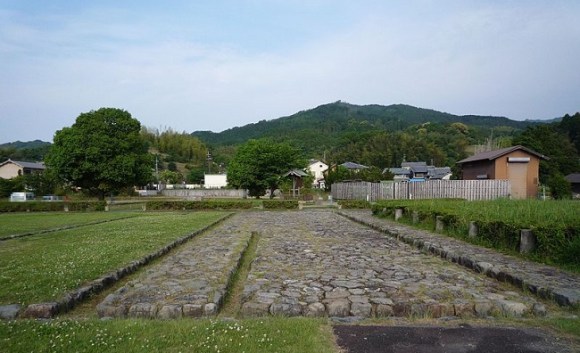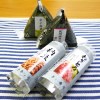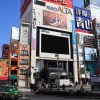
Though the current capital of Japan is Tokyo, many would argue that its traditional capital, Kyoto, is the real heart of Japan–at least culturally speaking. That said, if you you’re looking for the original capital of Japan, you’d probably be better heading south from Kyoto to Nara Prefecture. But while you should definitely stop and see Heijo-kyo in Nara City, you’ll have to keep heading south to Asuka Village to find the “real” original capital of Japan: Asuka-kyo. Of course, in the 1,300 years since the end of the Asuka Period, the capital has essentially been lost to time–all that’s left are stony remnants like those pictured above.
But that’s not the only patch of old ruins to be found in Asuka area–there are so many, they can actually get in the way of building a house! But with the news of the discovery of a piece of “cursed” earthenware, we have to wonder if maybe it’s just time for everyone to pack up and head for a slightly less historically significant area!
▼An aerial view of the excavation site where the dish was found.
While some might argue about where the “original capital” was–ask any group of Japanese history scholars where Queen Himiko resided (or if she were real) and get out the popcorn–Asuka Village is often considered one of the most important locations in the early history of Japan due to the ancient Asuka capital and the large number of ancient structures and kofun (tumults) like Ishibutai Kofun. As such, it should come as little surprise that extensive historical research is carried out in the area, largely headed by researchers at The Museum, Archaeological Institute of Kashihara, which is located in the Asuka Village’s neighbor Kashihara City.
The Institute opened its special fall exhibition last week and garnered quite a bit of national attention thanks to a rather unique piece of earthenware: One with what could only be described as “with a curse engraved on it”!
▼It’s more impressive than it looks, we promise…
https://twitter.com/lofylucyn/status/521601236064149505According to the researchers who have translated the text from the man’yōgana to something more readable in contemporary Japanese, the 3.1-centimeter-tall (1.2 inches) dish bears a message that boils down to: “If this is taken, a catastrophe will occur.” Umm…we can’t help wondering if this explains Typhoon Vongfong...
Nevertheless, researchers don’t seem to intimidated. In fact, the Institute has left the seriousness of the inscription open to interpretation. “It might have been written to demonstrate a temple’s (political) power, or it might have just been written as a joke.” Sure, it’s all fun and games until Prince Shotoku comes back as a zombie and attacks everyone.
However, they may not be worried since the dish was found during excavation of Japan’s oldest park/garden, Asuka-kyo’s Enchi, which probably looked something like this…
飛鳥京跡苑池遺構から松の木が植えられていた中島や苑池を見下ろす高台の建物跡が発掘され、そのイメージ図が橿原考古学兼研究所から公開され、今日の朝刊に掲載されていた。24日に現地説明会が行われるが、すでに予定があるため断念せざるを得ない。 pic.twitter.com/TAvZkiN1T9
— 河内太古 (@taiko3) November 21, 2013
It’s not exactly the most intimidating landscape we’ve seen, though the garden certainly looked a lot prettier 1,300 years ago than it does now…
▼Yep, it’s a real fixer-upper.
https://twitter.com/NH139/status/404126793134661632While the seriousness of the message is clearly debatable, it does, apparently, make the earthenware a bit of an oddity. Researchers have told media that it’s rather rare to find inscriptions on dishes like this. In fact, the earthenware could actually be of serious historical significance. While not all of the characters were legible, the inscription makes mention that dish was property of Kawara Temple, a Buddhist temple in the area that was of considerable political importance at the time. Though Kawara Temple is now little more than ruins, this inscription could hint at a very close connection between the temple and the political center of the Asuka Period.
Or it might have just been someone trying to troll his or her very distant descendants. Which gives us an idea…
If you’re in the Kansai area, be sure to stop by the The Museum, Archaeological Institute of Kashihara to see their autumn exhibition. The special exhibit will run until November 30 and entrance costs 800 yen (US$7.46). And if you have time, we highly recommend taking a stroll around Asuka Village, too. In this humble writer’s opinion, it’s one of the most beautiful places in Japan!
Sources: Japaaan, 47 News, Mainichi News
Images: Wikipedia (Osakaosaka)

 Dress like an aristocrat from the Nara period at new costume rental shop in Nara【Photos】
Dress like an aristocrat from the Nara period at new costume rental shop in Nara【Photos】 Nara’s “deer cookie” rice crackers get their first price increase in 28 years
Nara’s “deer cookie” rice crackers get their first price increase in 28 years Say goodbye to carved pumpkins because fruit faces will scare your socks off this Halloween
Say goodbye to carved pumpkins because fruit faces will scare your socks off this Halloween Genuine Muramasa blade and Muromachi katana on display at Tokyo’s Touken Ranbu store【Photos】
Genuine Muramasa blade and Muromachi katana on display at Tokyo’s Touken Ranbu store【Photos】 Enjoy the anniversary of the Evangelion Store with great new clothes and accessories
Enjoy the anniversary of the Evangelion Store with great new clothes and accessories McDonald’s new Happy Meals offer up cute and practical Sanrio lifestyle goods
McDonald’s new Happy Meals offer up cute and practical Sanrio lifestyle goods All-you-can-drink Starbucks and amazing views part of Tokyo’s new 170 meter-high sky lounge
All-you-can-drink Starbucks and amazing views part of Tokyo’s new 170 meter-high sky lounge Studio Ghibli releases new action figures featuring Nausicaä of the Valley of the Wind characters
Studio Ghibli releases new action figures featuring Nausicaä of the Valley of the Wind characters Starbucks reopens at Shibuya Scramble Crossing with new look and design concept
Starbucks reopens at Shibuya Scramble Crossing with new look and design concept Super Nintendo World expansion gets delayed for several months at Universal Studios Japan
Super Nintendo World expansion gets delayed for several months at Universal Studios Japan Studio Ghibli glasses cases let anime characters keep an eye on your spectacles
Studio Ghibli glasses cases let anime characters keep an eye on your spectacles 11 different ways to say “father” in Japanese
11 different ways to say “father” in Japanese The madness ends now: How to conqueror impossible-to-open Japanese convenience store snacks
The madness ends now: How to conqueror impossible-to-open Japanese convenience store snacks Gacha machine backpack is Japan’s hottest new fashion statement
Gacha machine backpack is Japan’s hottest new fashion statement Is it OK to bite through your ramen noodles while slurping them in Japan? Internet debates
Is it OK to bite through your ramen noodles while slurping them in Japan? Internet debates More foreign tourists than ever before in history visited Japan last month
More foreign tourists than ever before in history visited Japan last month Disney princesses get official manga makeovers for Manga Princess Cafe opening in Tokyo
Disney princesses get official manga makeovers for Manga Princess Cafe opening in Tokyo Beautiful new Final Fantasy T-shirt collection on the way from Uniqlo【Photos】
Beautiful new Final Fantasy T-shirt collection on the way from Uniqlo【Photos】 Is the new Shinkansen Train Desk ticket worth it?
Is the new Shinkansen Train Desk ticket worth it? Foreign English teachers in Japan pick their favorite Japanese-language phrases【Survey】
Foreign English teachers in Japan pick their favorite Japanese-language phrases【Survey】 Beautiful Sailor Moon manhole cover coasters being given out for free by Tokyo tourist center
Beautiful Sailor Moon manhole cover coasters being given out for free by Tokyo tourist center Studio Ghibli releases Kiki’s Delivery Service chocolate cake pouches in Japan
Studio Ghibli releases Kiki’s Delivery Service chocolate cake pouches in Japan Japan’s bone-breaking and record-breaking roller coaster is permanently shutting down
Japan’s bone-breaking and record-breaking roller coaster is permanently shutting down New definition of “Japanese whiskey” goes into effect to prevent fakes from fooling overseas buyers
New definition of “Japanese whiskey” goes into effect to prevent fakes from fooling overseas buyers Our Japanese reporter visits Costco in the U.S., finds super American and very Japanese things
Our Japanese reporter visits Costco in the U.S., finds super American and very Japanese things Studio Ghibli unveils Mother’s Day gift set that captures the love in My Neighbour Totoro
Studio Ghibli unveils Mother’s Day gift set that captures the love in My Neighbour Totoro Domino’s Japan now sells…pizza ears?
Domino’s Japan now sells…pizza ears? New Japanese KitKat flavour stars Sanrio characters, including Hello Kitty
New Japanese KitKat flavour stars Sanrio characters, including Hello Kitty One of Tokyo’s most famous meeting-spot landmarks is closing for good
One of Tokyo’s most famous meeting-spot landmarks is closing for good Kyoto creates new for-tourist buses to address overtourism with higher prices, faster rides
Kyoto creates new for-tourist buses to address overtourism with higher prices, faster rides Sales of Japan’s most convenient train ticket/shopping payment cards suspended indefinitely
Sales of Japan’s most convenient train ticket/shopping payment cards suspended indefinitely Sold-out Studio Ghibli desktop humidifiers are back so Totoro can help you through the dry season
Sold-out Studio Ghibli desktop humidifiers are back so Totoro can help you through the dry season Japanese government to make first change to romanization spelling rules since the 1950s
Japanese government to make first change to romanization spelling rules since the 1950s Ghibli founders Toshio Suzuki and Hayao Miyazaki contribute to Japanese whisky Totoro label design
Ghibli founders Toshio Suzuki and Hayao Miyazaki contribute to Japanese whisky Totoro label design Doraemon found buried at sea as scene from 1993 anime becomes real life【Photos】
Doraemon found buried at sea as scene from 1993 anime becomes real life【Photos】 Tokyo’s most famous Starbucks is closed
Tokyo’s most famous Starbucks is closed One Piece characters’ nationalities revealed, but fans have mixed opinions
One Piece characters’ nationalities revealed, but fans have mixed opinions We asked a Uniqlo employee what four things we should buy and their suggestions didn’t disappoint
We asked a Uniqlo employee what four things we should buy and their suggestions didn’t disappoint Princesses, fruits, and blacksmiths: Study reveals the 30 most unusual family names in Japan
Princesses, fruits, and blacksmiths: Study reveals the 30 most unusual family names in Japan Evangelion and pizza: The weird freeze-frame sight gags of Shin Godzilla
Evangelion and pizza: The weird freeze-frame sight gags of Shin Godzilla Cola-flavored mochi sweets are half Japanese tradition, half jiggly Pop Rock
Cola-flavored mochi sweets are half Japanese tradition, half jiggly Pop Rock Japan issuing beautiful new coins to celebrate Emperor Naruhito’s enthronement
Japan issuing beautiful new coins to celebrate Emperor Naruhito’s enthronement Pregnant anime voice actress photo standees: A new frontier in otaku merch
Pregnant anime voice actress photo standees: A new frontier in otaku merch “Draw Asuka!” — A.I.-created doodles are adorable, but aren’t quite there yet…
“Draw Asuka!” — A.I.-created doodles are adorable, but aren’t quite there yet… Japanese travelers are avoiding Kyoto as the city’s number of foreign visitors continues to grow
Japanese travelers are avoiding Kyoto as the city’s number of foreign visitors continues to grow We try extra-unique souvenir sold by soon-to-be world heritage site — silkworm chocolate!
We try extra-unique souvenir sold by soon-to-be world heritage site — silkworm chocolate! Miss school field trips? Now adults can go on a “school trip” too with new plan at Nara hotel
Miss school field trips? Now adults can go on a “school trip” too with new plan at Nara hotel Limited edition Evangelion Asuka Telecasters on sale this June
Limited edition Evangelion Asuka Telecasters on sale this June Travelers can destroy roof tiles with martial arts strikes at new business in Tokyo【Videos】
Travelers can destroy roof tiles with martial arts strikes at new business in Tokyo【Videos】 Amazing pics from Kyoto/Nara “bullet tour” show no matter how tight your schedule, you should go
Amazing pics from Kyoto/Nara “bullet tour” show no matter how tight your schedule, you should go Evangelion Store popularity contest reveals surprising results for a former fan favorite
Evangelion Store popularity contest reveals surprising results for a former fan favorite The cosplay of Tokyo Game Show 2014 【Photos】
The cosplay of Tokyo Game Show 2014 【Photos】 Katana coasters! Samurai sword tableware brings bushido to your home
Katana coasters! Samurai sword tableware brings bushido to your home Thinking about moving to Nara? Here are eight things that may surprise you!
Thinking about moving to Nara? Here are eight things that may surprise you! Afro Buddha, usually only displayed one day a year, gets rare extended viewing until mid-October
Afro Buddha, usually only displayed one day a year, gets rare extended viewing until mid-October
Leave a Reply